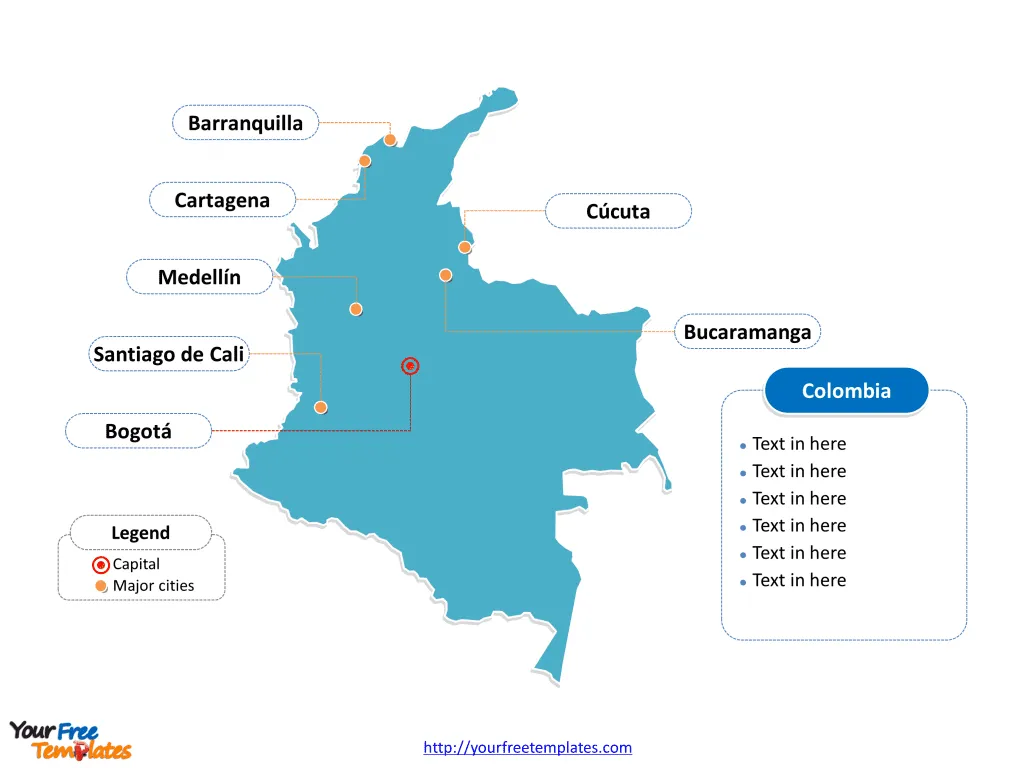The Colombia Map Template includes two slides. Colombia map with 32 departments and one capital district, highlighting Antioquia, Atlántico, Bogotá (Capital District), Cundinamarca and Valle del Cauca departments. Colombia map labeled with Bogotá, Antioquia, Valle del Cauca, Cundinamarca, and Atlántico cities.
Colombia is strategically located in the northwest corner of South America, where it is the only country on the continent to have coastlines on both the Pacific Ocean and the Caribbean Sea. Its geographical coordinates roughly fall between 4° north latitude and 72° west longitude.
Colombia shares its borders with five countries: to the east, it is bordered by Venezuela and Brazil; to the south, it meets Peru and Ecuador; and to the northwest, it shares a border with Panama. This unique positioning not only influences its diverse ecosystems and climates but also its cultural and economic connections within the region.
Slide 1, Colombia map labeled with capital and major cities.
Colombia, a country with a rich cultural heritage and diverse landscapes, is divided into several major cities and departments, each contributing uniquely to the nation’s identity and growth. Among these, Bogotá, Antioquia, Valle del Cauca, Cundinamarca, and Atlántico stand out as major urban centers, while the departments of Antioquia, Atlántico, Bogotá (Capital District), Cundinamarca, and Valle del Cauca play pivotal roles in the country’s administrative and economic structure.
Major Cities on Colombia map
Bogotá The capital city, Bogotá, is not only the political and administrative heart of Colombia but also a major cultural and economic hub. Accounting for 25.5% of the country’s GDP, Bogotá boasts a vibrant economy with an average growth of 3.4% over the last decade. The city is a significant center for foreign trade, contributing to 32.6% of Colombia’s total value in foreign trade transactions. With 33% of the nation’s enterprises, including over 1,500 foreign companies, Bogotá is a dynamic metropolis offering vast opportunities across various sectors.

Antioquia (Medellín) Medellín, the capital of Antioquia Department, is renowned for its innovative approach to urban development and social programs, earning it the title of the “City of Eternal Spring.” As the heart of Colombia’s textile industry and a major regional trade fair venue, Medellín promotes a strong industrial and technological environment. The city is also pioneering in adopting Industry 4.0 technologies, hosting the Center for the Fourth Industrial Revolution.
Valle del Cauca (Cali) Santiago de Cali, the capital of Valle del Cauca, stands as Colombia’s third-largest city. This region is one of the most industrialized in the country, highlighted by its dynamic and competitive logistics environment. Cali’s strategic location and the presence of the most important seaport on the Colombian Pacific coast facilitate domestic and international trade, enhancing its economic significance.
Cundinamarca Although not a city, Cundinamarca encompasses Bogotá and serves as a critical surrounding region supporting the capital’s needs and activities. It plays a crucial role in the nation’s agricultural sector, providing a significant portion of the food consumed in Bogotá.
Atlántico (Barranquilla) Barranquilla, the capital of Atlántico Department, is a strategic port city located at the delta of the Magdalena River. Known as a major industrial, shopping, educational, and cultural center of the Caribbean Region of Colombia, Barranquilla is pivotal for river and maritime transportation within the country. Its metropolitan area includes several municipalities, making it a significant urban conglomerate with a diverse economy.
Slide 2, Colombia map labeled with major administration districts.
Colombia is a country divided into 32 departments and one capital district, Amazonas, Antioquia, Arauca, Atlántico, Bogotá (Capital District), Bolívar, Boyacá, Caldas, Caquetá, Casanare, Cauca, Cesar, Chocó, Córdoba, Cundinamarca, Guainía, Guaviare, Huila, La Guajira, Magdalena, Meta, Nariño, Norte de Santander, Putumayo, Quindío, Risaralda, San Andrés y Providencia, Santander, Sucre, Tolima, Valle del Cauca, Vaupés, and Vichada. Every individual political subdivision is an editable shape.
Major Departments on Colombia map
Antioquia The Department of Antioquia, with Medellín as its capital, is a powerhouse of innovation and industry. It’s a region characterized by its robust economic performance, with a strong emphasis on manufacturing, technology, and fashion. Antioquia’s commitment to social and urban transformation projects has set benchmarks globally.
Atlántico Atlántico is crucial for Colombia’s economy due to its capital, Barranquilla, a key port and industrial city. The department plays a significant role in the country’s logistics, trade, and cultural activities, contributing to the vibrant Caribbean essence of Colombia.
Bogotá (Capital District) The Capital District of Bogotá, standing as a separate entity, is the epicenter of Colombia’s political, financial, and cultural life. It houses the national government, several universities, and numerous multinational companies, making it a global city with significant influence.

Cundinamarca Surrounding Bogotá, Cundinamarca provides vital resources and services to the capital. Its diverse climate allows for varied agricultural production, which is critical for the country’s food supply. Moreover, its proximity to Bogotá facilitates strong economic and social interdependence.
Valle del Cauca Valle del Cauca is distinguished by its economic diversity, with a strong presence in industries such as agribusiness, manufacturing, and logistics. The department’s capital, Cali, plays a central role in this economic activity, supported by the strategic port city of Buenaventura, which is vital for international trade.
Please check our premium maps in ofomaps.com.
Size: 103K
Type: PPTX
Aspect Ratio: Standard 4:3
Click the blue button to download it.
Download the 4:3 Template
Aspect Ratio: Widescreen 16:9
Click the green button to download it.
Download the 16:9 Template














